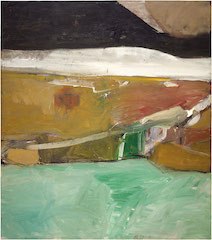The lure of a private art collection is intimacy. We can absorb and contemplate the works however we wish, without the subtle pressure that comes with sharing the viewing experience in public. Such is the intention behind the Anderson Collection at Stanford University, set to open in September 2014 inside a new building designed by Richard Olcott of Ennead Architects.

Architect Richard Olcott’s illustration of the Anderson Collection gallery
The Anderson Collection was assembled over the past 50 years by Bay Area locals Harry W. “Hunk” and Mary Margaret “Moo” Anderson, along with their daughter Mary Patricia “Putter” Anderson Pence. The self-educated trio assembled their collection without curators, thus far amassing 837 works by 203 artists; their gift of 121 works by 86 artists will be displayed at Stanford. Considered among the world’s most impressive private holdings of 20th century American art, the Anderson Collection features abstract expressionist heavyweights, such as Jackson Pollock and Willem de Kooning, plus contemporary painters, and a cadre of California artists.

The Anderson family with Terry Winters’ painting Dumb Compass
From Richard Diebenkorn, whose softly colored Ocean Park series began to take shape in Santa Monica in the late 1960s, to Philip Guston, whose emotional extremes carried his work from figurative to abstract to symbolic and cartoonish, the Andersons fell for an endlessly intriguing group of post-World War II artists. The breadth of the collection calls for a responsive setting, one that is inclusive and adaptable.

Wayne Thiebaud’s Candy Counter 1962, oil on canvas, from the Anderson Collection © WayneThiebaud/Licensed by VAGA, New York, NY
Olcott is working with Jason Linetzky, Founding Director of the Anderson Collection at Stanford and the Andersons’ longtime private collection manager, to preserve the family’s accessible style of displaying art at home. Pollock’s Lucifer adorned the wall above Putter’s childhood bed, for example, while other paintings were hung well below eye-level, and seemingly mismatched sculptures dotted tabletops and floors.

A rendering of the lobby inside the Anderson Collection gallery
The gallery design encourages viewers to follow their curiosity instead of a stipulated program. Openings between the gallery walls let viewers see the striking central staircase, which in turn permits views of art work from the lobby to upper-level main galleries. Large-scale windows looking out over heritage trees, the sculpture garden, and Stanford’s arts district enhance an atmosphere of continuity with the surrounding landscape.

A nighttime rendering of the Anderson Collection gallery at Stanford University
The intention is to completely avoid electrical lighting, except at night, when the glassy gallery will have a lantern-like glow sure to entice students across disciplines—Stanford made creative expression a general education requirement last year. Says Matthew Tiews, Executive Director of Arts Programs at Stanford, “This is something we want every student to engage in.”







